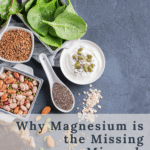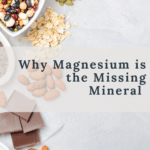Why Magnesium is the Missing Mineral
January 27, 2017 by Ginger Hultin MS RDN
Magnesium is known as the “master mineral” because it is directly involved in so many essential processes in the body. Deficiencies are associated with a variety of symptoms including muscle cramps, depression, and fatigue. Magnesium is a part of key enzymes, or chemicals in the body that help regulate energy within the cells. It is also an important nutrient for bone and nerve health. Up to 75% of people are not getting enough magnesium in their diets and this is why magnesium is the missing mineral. I don’t want this to happen to you!
In this blog you’ll learn if you are at risk for deficiency, and what to do about it. If you are just here for some recipes featuring magnesium-rich foods to make eating more easy and delicious, check these out:
If you’ve ever suffered from migraines, depression, or muscle cramps, read on to find out if you might be at risk for a magnesium deficiency.
Who is at risk for magnesium deficiency?
Magnesium is absorbed in the small intestine. Disorders that damage the digestive tract and interfere with nutrient absorption including celiac, Crohn’s, and IBD increases your risk for a magnesium deficiency. Women, older adults, and adults with type II diabetes are also at higher risk. It’s easy to fall below the recommended 300-400 mg/day intake if you aren’t getting enough variety in your diet. Chronic diseases are definitely a reason why magnesium is the missing mineral.
What are the signs of a magnesium deficiency?
Signs you could be in trouble include muscle twitching or cramps, mental health disorders like depression, fatigue, weakness, and irregular heartbeat, among others. Since magnesium is essential for the metabolism and absorption of vitamin D and calcium, a deficiency can lead to osteoporosis (a disease where bone lose their density and are at increased risk of breaking).
Magnesium is found mostly within the cells, muscles and bones, not floating around in the blood so getting a blood test isn’t always the best way to determine if you’re getting enough. A doctor will diagnose hypomagnesemia (low magnesium) based on numerous factors including symptoms, history, physical exam and a blood test.
How Much Magnesium do I need?
The minimum recommended daily allowance for magnesium is 310-320 mg for women and 400-420 mg for men. If you eat a whole-foods based diet rich in unprocessed, food you are likely getting enough but many Americans aren’t meeting their needs due to a low-quality, highly processed diet. For example, whole wheat is rich in magnesium but when it is processed, the germ and bran are removed leaving white flour for crackers, bread, pasta and baked goods devoid of this important mineral.
Why Magnesium is the Missing Mineral
Concerned about the mineral content of your produce? Recent headlines have raised concerns that nutrient depletion of our soils are making crops less nutritious than in past decades. However, evidence shows that the variations observed in nutrient levels are within the ranges expected when taking into consideration differences due to testing techniques, geographic origin, crop varieties, and sampling methods. So yes, it’s possible to meet your daily requirements of magnesium (and other micronutrients) through food intake alone.

Where to Find Magnesium
Magnesium is plentiful in a variety of fruits, vegetables, nuts, seeds, and whole grains. Toxic effects have not been identified from eating food sources rich in magnesium, so if you love these healthy foods, no need to hold back.
Reach your 300-400 mg daily intake by including the following foods in your diet:
- Beans: antioxidant rich black beans offer 120mg of magnesium in 1 cup. Serve vegetarian black bean tacos, make black bean brownies (double bonus because cocoa is so rich in magnesium!), or sprinkle on a salad for added protein and fiber.
- Whole grains: a variety of whole grains are rich in magnesium. ¾ cup quinoa offers 118 mg magnesium and 1 cup of brown rice contains over 80 mg.
- Nuts: cashews are particularly rich in magnesium; just ¼ cup, you get 117 mg magnesium. Add cashews to stir fry dishes or grind into a creamy cashew butter to spread on fresh fruit.
-
- Seeds: 1 ounce of pumpkin seeds contain 150 mg of magnesium! Use them year round in trail mix or added to cereal or salads for a magnesium punch to your meals.
- Spinach: 1 cup of spinach provides 156 mg of magnesium. Vegetables like spinach and broccoli are rich in magnesium because it is part of the chlorophyll molecule – the compound that makes plants green. Add spinach to any salad, omelet, or smoothie for a boost of magnesium and other health benefits.
- Fruits: A single banana contains 32 g of magnesium. One cup of avocado contains 44 mg. Both make a great addition to any smoothie for their smooth texture.
- Fish: You’ll get 40 mg of magnesium from 5 ounces of salmon (about the size of an iphone 7). Salmon is also a great source of heart-healthy and antiinflammatory omega-3 fatty acids.
- Chocolate: one of the most magnesium rich foods, offers 40 grams of magnesium per tablespoon. Blend cocoa powder into smoothies, yogurt, or chia pudding for a non-dessert incorporation of this delicious food.
Snack ideas:
Peanut butter sandwich on whole wheat
→ 2 tbsp PB + 2 slices whole wheat bread = 96 mg
Overnight oats, banana & hempseeds
→ ½ cup oats, ½ cup soymilk, ½ banana, 1 tbsp hemp seeds = 145 mg
→ 2 cups soymilk + 1 tbsp cocoa powder + 1 frozen banana = 130 mg
Magnesium Supplements
While higher levels of magnesium are associated with better health outcomes, it is unclear whether this can be achieved using magnesium supplements. Most of the information we have is on magnesium rich diets, which tend to be rich in other vitamins and minerals. Magnesium works synergistically with other nutrients, so it is best to consume magnesium rich foods when possible. It is best to discuss with a trusted healthcare provider if a magnesium supplement is right for you.
If you have worries about meeting your magnesium needs or any other vitamin or mineral, it’s time to talk. Reach out to me here and we’ll discuss!
1 Comments
Leave a Comment

Ginger Hultin,MS, RD, CSO
Thanks for visiting! If you're struggling with a cancer diagnosis, autoimmune condition, gut health problems, or even a medical mystery, nutrition can make a HUGE difference in your day-to-day life. I run a virtual, concierge private practice where I partner with my clients over time to help them improve their health through nutrition. Be sure to visit the blog for easy, plant-based, anti-inflammatory recipes and our "Resources" page for a variety of self-paced programs, books, e-books, and nutrition podcast episodes.






Great info- I am going to try those snack ideas!